The 6th
LaureateSculpture
Richard Serra
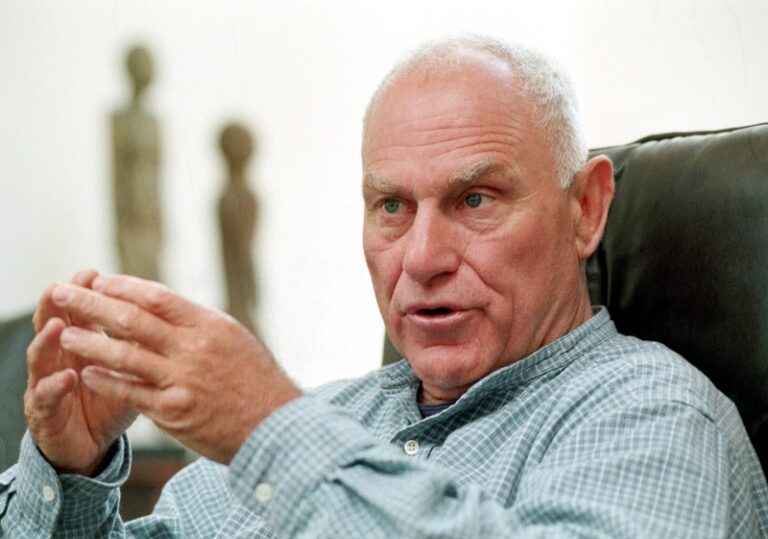
Richard Serra’s work is probably the most influential American sculpture of the last 30 years. While studying in Paris he would draw every day in Brancusi’s studio,which had been reconstructed in the Musée d’Art Moderne. His friendships with Robert Smithson and Robert Morris were reflected in his early work; later pieces in which large sheets of industrial steel were propped against each other had a tangible link to the work of the minimalists Carl Andre and Donald Judd. Serra went on to create many large-scale public sculptures in which the public’s interaction with the work plays a dominant role. This can sometimes be difficult: his Tilted Arc for Federal Plaza was destroyed by a reactionary authority after public complaints; it remains,however,a masterpiece of sculptural intervention within the cityscape.
Biography
Richard Serra’s most celebrated public sculpture in the United States is one that no longer exists. Tilted Arc,commissioned for Federal Plaza in New York in 1979 and installed in 1981 (after which President Jimmy Carter congratulated him for his contribution to the cultural heritage of the United States),was removed on 15 March 1989 after a succession of popular protests and actions in the law courts. As the artist pointed out,since the piece was site-specific,its removal in fact amounted to its total destruction.
Serra’s work is probably the most influential American sculpture of the last 30 years,yet its immediate ancestry is not in the sculpture of predecessors such as David Smith,but in industrial constructions of all kinds,in the ‘logic of towers,dams,silos,bridges,tunnels,skyscrapers.’ During his student days in California he had often earned money for his tuition by working in steel mills and on construction sites,and so the industrial ethos was not new to him. This subject matter reinforced the necessity for change in a practice that had previously been largely studio-based. As Serra pointed out in 1984: ‘My decision to build site-specific works in steel took me out of the traditional studio. The studio has been replaced by urbanism and industry. I rely upon the industrial sector to build my work,upon structural and civil engineers,upon surveyors,labourers,transporters,riggers,construction workers etc… steel mills,shipyards and fabricating plants have become my on-the-road extended studios.’
Serra lived in Paris between 1964 and 1965 on a Yale Travelling Fellowship,for four months of which he went to draw every day in Brancusi’s studio,which had been reconstructed at the Musée d’Art Moderne. One of the things which impressed him most about the studio was that ‘there was no separation between living space and working space’ and that both were completely integrated – an axiom that was later to determine the nature of his urban public sculpture in occupying people’s living and work spaces at the same time. Leaving Paris he travelled around Europe for a year before settling in New York in 1966. The work he had made in Europe prefigured the activity of the arte povera movement in Italy and his sculpture continued in this vein in New York,with a series of rubber and neon tubing works,such as Belts,1966–67,and work like Scatter Piece,1967,in which quantities of rubber latex waste are scattered across the floor. These works,as well as his lead ‘splashing’ pieces of 1968,helped to create his early reputation and placed him at the heart of the process/anti-form movement which included such artists as Robert Morris,Eva Hesse,Bruce Nauman and Robert Smithson. However,his ‘Prop’ pieces of 1969,in which large sheets of lead or steel are propped against each other,or held against the wall by other sheets or tubes of metal,marked a decisive move away from the anti-form work. Their sparse aesthetic,along with his barely inflected use of industrial materials,form a tangible connection with the work of his friends Carl Andre and Donald Judd,and provides evidence for his growing identification with minimalism.
In 1970,after helping Robert Smithson and Nancy Holt in the construction of Spiral Jetty,Serra travelled to Japan to participate in the Tokyo Biennale. During this visit he worked for a time in Kyoto,where he studied the gardens at the Myoshin-ji temple complexes. These,like the earlier impact of Brancusi’s studio and his close friendship with Smithson (after his death,in 1974,Serra completed Smithson’s Amarillo Ramp in Texas with Holt and Tony Shafrazi) helped him to formulate his decision to concentrate almost entirely on site-specific landscape works,such as the three-part Spin Out: For Bob Smithson,1972–73,or largely urban public commissions such as Tilted Arc,the 1977 Terminal in Bochum or Clara-Clara,1983,that was first installed at the Tuileries gardens in Paris. With his site-specific work,Serra has consistently questioned the erroneous connection that is often made between the image of a work and one’s actual experience of it: this issue lay at the heart of the tragic destruction of Tilted Arc.
Serra’s work is never inert – it always presupposes some kind of public interaction and is most often at its most intense and challenging outside a museum context. He is,in his own words,engaged in making ‘sculpture that stands for and contains a complexity of possible experiences,that becomes something that anyone can use to walk into and through,that is open to any response,hopefully to enrich people’s minds in some small way.’
Edward Lucie-Smith
Chronology
-
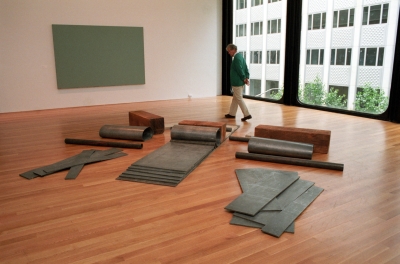
Cutting Device
-
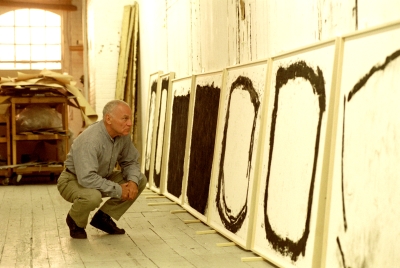
At his studio
-
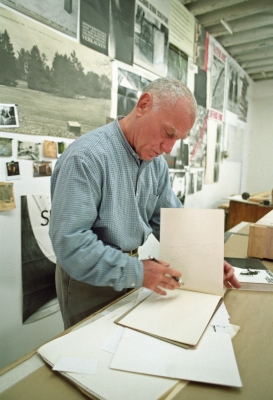
At his studio
-
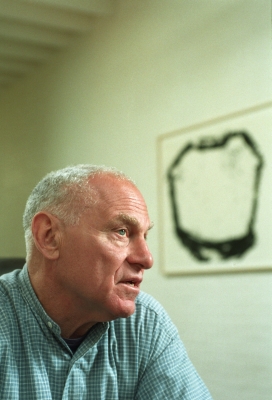
At his studio

